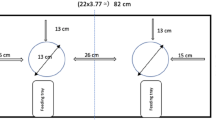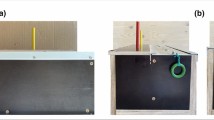Abstract
The ability to learn through imitation is thought to be the basis of cultural transmission and was long considered a distinctive characteristic of humans. There is now evidence that both mammals and birds are capable of imitation. However, nothing is known about these abilities in the third amniotic class—reptiles. Here, we use a bidirectional control procedure to show that a reptile species, the bearded dragon (Pogona vitticeps), is capable of social learning that cannot be explained by simple mechanisms such as local enhancement or goal emulation. Subjects in the experimental group opened a trap door to the side that had been demonstrated, while subjects in the ghost control group, who observed the door move without the intervention of a conspecific, were unsuccessful. This, together with differences in behaviour between experimental and control groups, provides compelling evidence that reptiles possess cognitive abilities that are comparable to those observed in mammals and birds and suggests that learning by imitation is likely to be based on ancient mechanisms.




Similar content being viewed by others
References
Akins CK, Zentall TR (1996) Imitative learning in male Japanese quail (Coturnix japonica) using the two-action method. J Comp Psychol 110:316–320
Boyd R, Richerson PJ (1988) An evolutionary model of social learning: the effects of spatial and temporal variation. In: Zental TR, Galef BG Jr (eds) Social learning: psychological and biological perspectives, pp 29–48
Byrne RW (2003) Imitation as behaviour parsing. Philos Trans R Soc Lond B Biol Sci 358:529–536
Byrne RW, Tanner JE (2006) Gestural imitation by a gorilla: evidence and nature of the capacity. Int J Psychol PsycholTher 6:215–231
Call J (2001) Body imitation in an enculturated orangutan (Pongo pygmaeus). Cybernet Syst 32:97–119
Custance D-M, Whiten A, Bard KA (1995) Can young chimpanzees (Pan troglodytes) imitate arbitrary actions? Hayes and Hayes (1952) revisited. Behaviour 132:837–859
Davis KM, Burghardt GM (2011) Turtles (Pseudemys nelsoni) learn about visual cues indicating food from experienced turtles. J Comp Psychol 125:404–410
Dawson BV, Foss BM (1965) Observational learning in Budgerigars. Anim Behav 13:470–474
Doody JS, Burghardt GM, Dinets V (2012) Breaking the social-non-social dichotomy: a role for reptiles in vertebrate social behavior research? Ethology 119:95–103
Herman LM (2002) Vocal, social, self-imitation by bottle- nosed dolphins. In: Dautenhahn K, Nehaniv CL (eds) Imitation in animals and artifacts. MIT Press, Cambridge
Heyes C, Huber L, Gergely G, Brass M (2009) Evolution, development and intentional control of imitation (special issue). Philos Trans R Soc Lond B Biol Sci 364:2291–2443
Huber L, Range F, Voelkl B, Szucsich A, Viranyi Z, Miklosi A (2009) The evolution of imitation: what do the capacities of nonhuman animals tell us about the mechanisms of imitation? Philos Trans R Soc Lond B Biol Sci 364:2299–2309
Klein ED, Zentall TR (2003) Imitation and affordance learning by pigeons (Columba livia). J Comp Psychol 117:414–419
Meltzoff AN (1988) The human infant as homo imitans. In: Zental TR, Galef BG Jr (eds) Social learning: psychological and biological perspectives, pp 319–341
Miller HC, Rayburn-Reeves R, Zentall TR (2009) Imitation and emulation by dogs using a bidirectional control procedure. Behav Proc 80:109–114
Moore BR (1992) Avian movement imitation and a new form of mimicry: tracing the evolution of a complex form of learning. Behaviour 122:231–263
Müller C, Cant M (2010) Imitation and traditions in wild banded mongooses. Curr Biol 20:1171–1175
Myowa-Yamakoshi M, Matsuzawa T (2000) Imitation of intentional manipulatory actions in chimpanzees (Pan troglodytes). J Comp Psychol 114:381–391
Noble DWA, Byrne RW, Whiting MJ (2014) Age-dependent social learning in a lizard. Biol Lett 10:20140430
Pesendorfer MB, Gunhold T, Schiel N, Souto A, Huber L, Range F (2009) The maintenance of traditions in marmosets: individual habit, not social conformity? A field experiment. PLoS ONE 4:e4472
Range F, Viranyi Z, Huber L (2007) Selective imitation in domestic dogs. Curr Biol 17:1–5
Subiaul F, Cantlon JF, Holloway RL, Terrace HS (2004) Cognitive imitation in rhesus macaques. Science 305:407–410
Tchernichovski O (2001) Dynamics of the vocal imitation process: how a zebra finch learns its song. Science 291:2564–2569
Thorndike EL (1898) Animal intelligence: an experimental study of the associative processes in animals. Psychol Rev Monogr Suppl 2:79
Thorpe WH (1956) Learning and instinct in animals. Methuen, London
Tomasello M, Savage-Rumbaugh ES, Kruger AC (1993) Imitative learning of actions on objects by children, chimpanzees, and enculturated chimpanzees. Child Dev 64:1688–1705
Topál J, Byrne RW, Miklósi Á, Csányi V (2006) Reproducing human actions and action sequences: “Do as I Do!” in a dog. Anim Cogn 9:355–367
Voelkl B, Huber L (2000) True imitation in marmosets. Anim Behav 60:195–202
Voelkl B, Huber L (2007) Imitation as faithful copying of a novel technique in marmoset monkeys. PLoS ONE 2:e611
Wilkinson A, Huber L (2012) Cold-blooded cognition: Reptilian cognitive abilities. In: Vonk J, Shackelfor TK (eds) The Oxford Handbook of Comparative Evolutionary Psychology. Oxford University Press, New Jersey, pp 129–143
Wilkinson A, Mandl I, Bugnyar T, Huber L (2010a) Gaze following in the red-footed tortoise (Geochelone carbonaria). Anim Cogn 13:765–769
Wilkinson A, Kuenstner K, Mueller J, Huber L (2010b) Social learning in a non-social reptile (Geochelone carbonaria). Biol Lett 6:614–616
Wood LA, Kendal RL, Flynn EG (2013) Copy me or copy you? The effect of prior experience on social learning. Cognition 127:203–213
Zentall TR (2006) Imitation: definitions, evidence, and mechanisms. Anim Cogn 9:335–353
Acknowledgments
We thank L. Stepniewska, V. Clarke, J. Murray, M. Gácsi for assistance and Boróka Bereczky for reliability coding. Supported by ESF Programme “The Evolution of Social Cognition”.
Conflict of interest
The authors declare that they have no conflict of interest.
Ethics standard
The experiment reported in this paper complies with the laws of the country in which it was performed (UK).
Author information
Authors and Affiliations
Corresponding author
Electronic supplementary material
Below is the link to the electronic supplementary material.
Supplementary material 2 (AVI 1218 kb)
Supplementary material 3 (AVI 1234 kb)
Supplementary material 4 (AVI 2067 kb)
Supplementary material 5 (AVI 4082 kb)
Supplementary material 6 (AVI 6056 kb)
Rights and permissions
About this article
Cite this article
Kis, A., Huber, L. & Wilkinson, A. Social learning by imitation in a reptile (Pogona vitticeps). Anim Cogn 18, 325–331 (2015). https://doi.org/10.1007/s10071-014-0803-7
Received:
Revised:
Accepted:
Published:
Issue Date:
DOI: https://doi.org/10.1007/s10071-014-0803-7




